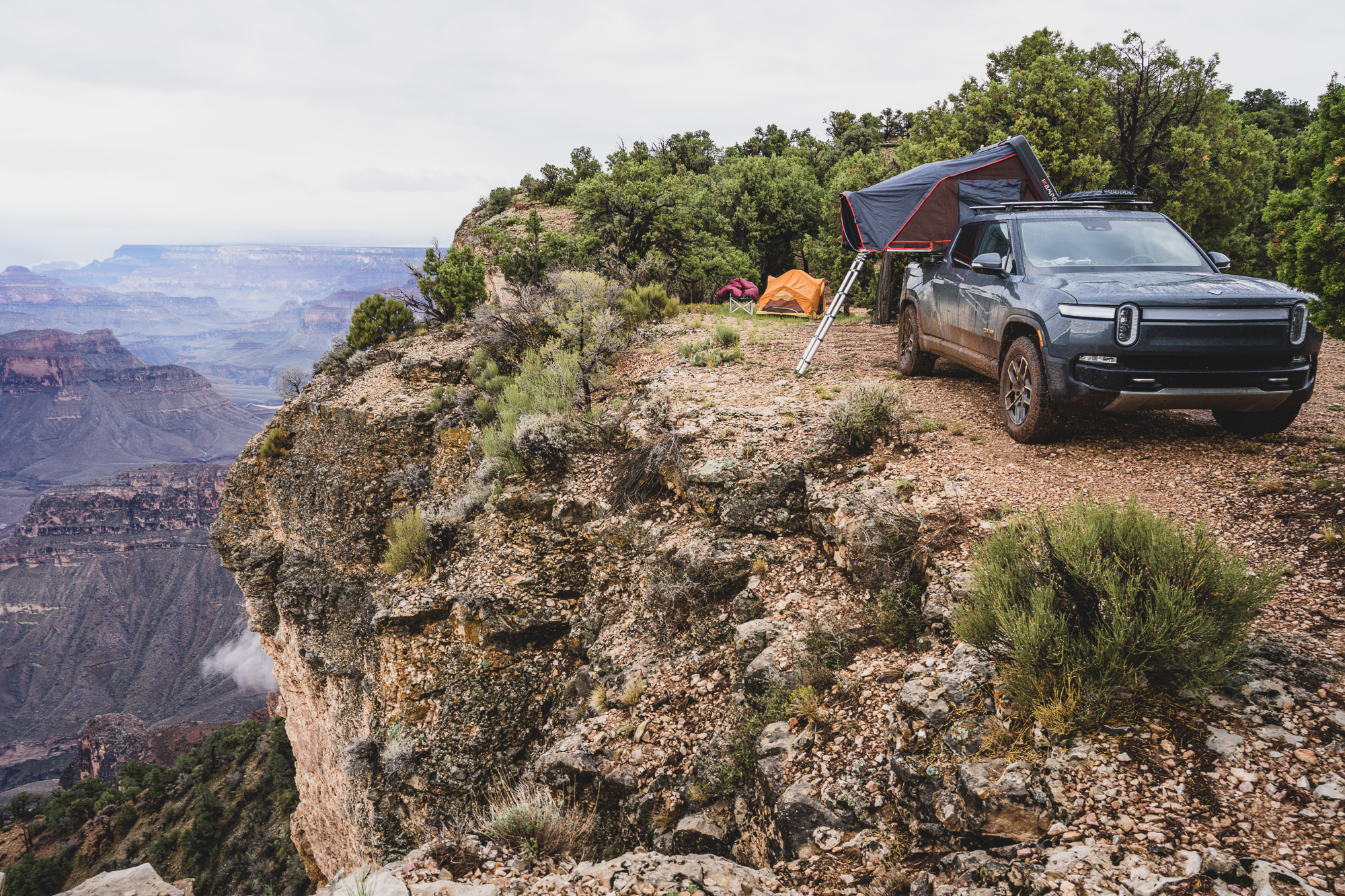Editor’s Note: This electric vehicle article was originally published in Overland Journal’s Spring 2023 Issue.
Electric overlanding is here and represents an exciting new option for vehicle-based travel. We are not suggesting that EVs will work for everyone, but they represent a compelling set of attributes that will target the needs of many adventurers. From the advanced integration of the technologies to the near-silent operation to the significant reduction in service and maintenance costs (these trucks only have one fluid to top off, the windshield washing reservoir), electric vehicles have distinct advantages. For Overland Journal, it was important to test and evaluate these new offerings and share the good, the bad, and the blisteringly fast about this first crop of EV trucks.
For this test, we restricted entries to fully electric trucks with an open bed and all-wheel drive. The contenders are the Ford Lightning XLT, the GMC Hummer EV Edition One, and the Rivian R1T Launch Edition. While these vehicles look similar on a features list, they could not be more different upon full inspection. There are several hybrid trucks on the market, but there are currently no plugin hybrid variants (PHEV Gladiator, please). The PHEV is one of the most compelling practical solutions for most drivers, and our experiences with the Grand Cherokee and Wrangler were both exceptional. However, this test is all about electrons.
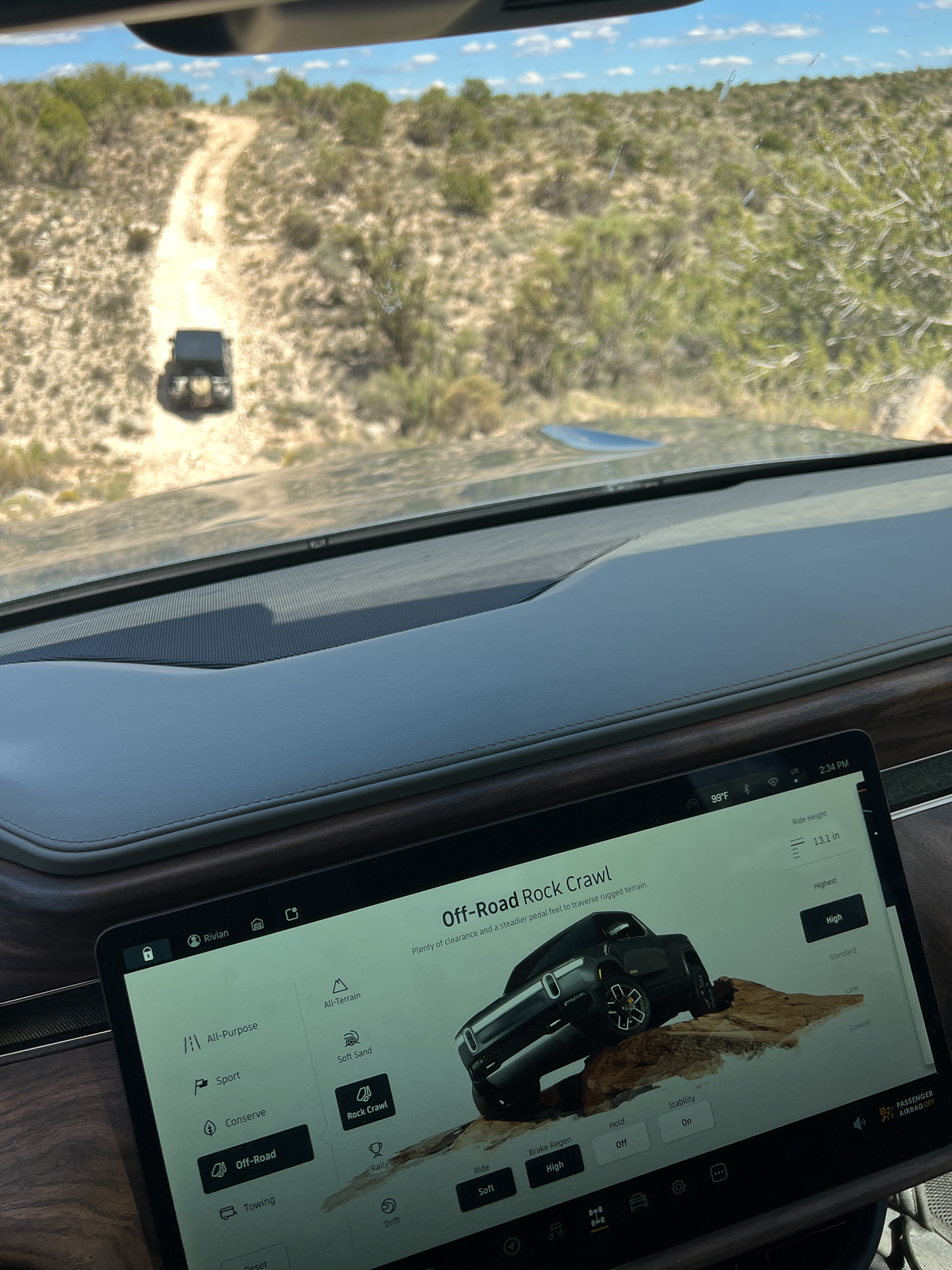

Left: All of the EVs in this test are independent suspension front and rear, which has pros and cons. The Hummer had articulation similar to most stock SUVs, but the Rivian performed the best on the ramp. Right: EVs are a bit of a technology deep dive, with so many options to optimize performance and range. The modes make a significant difference in the outcome.
Considerations
Electric vehicles are truly amazing, but they are not perfect. After spending the last six months testing EV after EV, I have come to terms with many of their strengths and shortcomings.
Silent Operation on the Trail: This is my favorite thing about EVs. They are so quiet that you can hear the wind through the trees, the interaction of the tires to the terrain (which improves driver inputs), and even the sounds of birds or an elk bugling. The vehicle also spares other outdoor users the petulant wailing of a loud exhaust, and the animals seem unbothered by the vehicle’s approach.
Less Expensive to Fill Up Charging the Rivian R1T from 20 percent to 80 percent costs less than $20 at the Overland Journal offices. Many level-two chargers (12-80 mph charge rate) are free at hotels, and level-three chargers (75-1,200 mph charge rate) cost less than $60 to achieve the same result. Filling an internal combustion engine vehicle of the same size would currently cost twice that. If charged at home, the cost is low and saves time at the pump, but it will take longer to charge.
Driving Experience Most EVs are a blank slate design, so they drive better and include countless driver aids that lower fatigue and improve safety (in most cases). The entire vehicle operates in milliseconds to respond to changing conditions. One 0-60 run in a Hummer EV will melt away any bias.
Charge Anywhere Anywhere you can plug in 120 or 220 volt, you can charge these EVs, but speeds will vary widely. The hack is to use an RV site with 50-amp service, which will yield 12-16 mph of charge, and you can sleep right in the roof tent. We have a 50-amp outlet at our offices, so the vehicle is always ready to go at the end of the work day. However, read on.
Fast Charging Infrastructure is a Dumpster Fire Finding a functioning and available fast charger anywhere outside a metropolitan area is like hen’s teeth. They are not only rare, but they are often inoperable or occupied. Tesla chargers are far better, and all but the Superchargers can be used by the vehicles in this test (with an adapter). There is also significant variability in charging performance, with most hotel chargers being in the 5- to 10-kilowatt range.
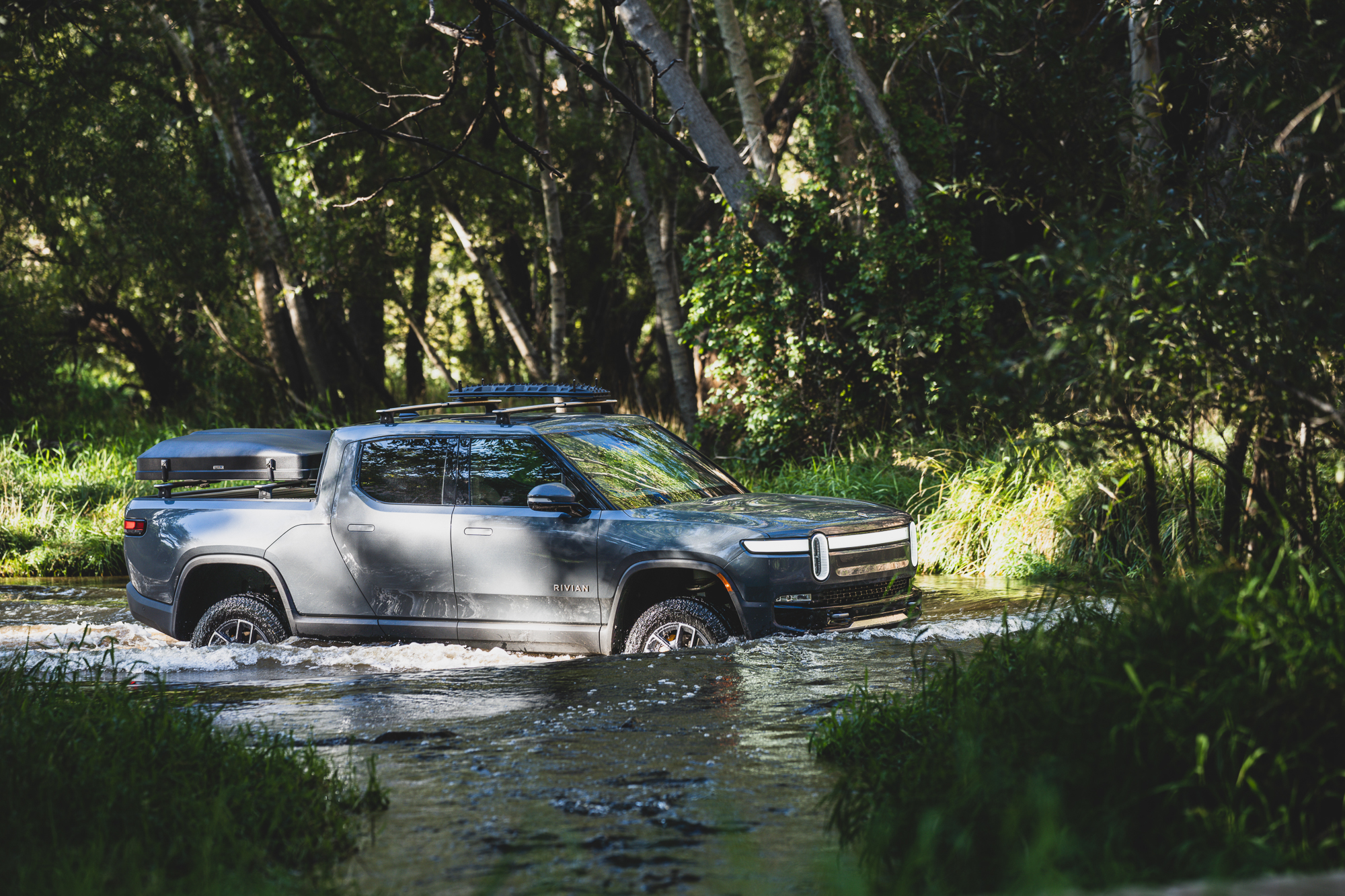
Fortunately, the engineers also addressed water fording with EVs, and they can cross similar depths to gasoline engine models. All of the electronics are sealed.
Towing Troubles These EV trucks are wonderful tow vehicles for overland trailers, but there are two issues. EVs are slightly less efficient at towing the same load as an internal combustion engine (ICE) or gas-powered vehicle, but it is primarily the charge that becomes the limiting factor. With half the range, most fast charges are simply out of reach, and few are set up to accommodate the trailer attached. At this time, overland towing is not a good fit for EVs due to the charge infrastructure, but new trailers are coming to market with their own battery banks to drive the trailer wheels or charge the tow vehicle.
Ledges and Large Rocks We can make this easy and just make it clear that the current crop of EVs does not work well on ledges and large rocks. The electric motor needs a low rpm to develop all that torque, but since these vehicles lack a clutch or torque converter, they cannot get from 0 to 1 rpm while pressing against the rock surface. A bit of momentum is required, often with dire consequences. Start bouncing a 9,000-pound EV up against a rock, and something is going to give in a dramatic way.
EVs Are a Luxury You can buy a 10-year-old Lexus GX for less than $30,000, and it will easily last another 10 years. These EVs cost an average of $100,000 and, even in ideal conditions, will need a $30,000 battery in 12-14 years. That makes EVs expensive new and used.
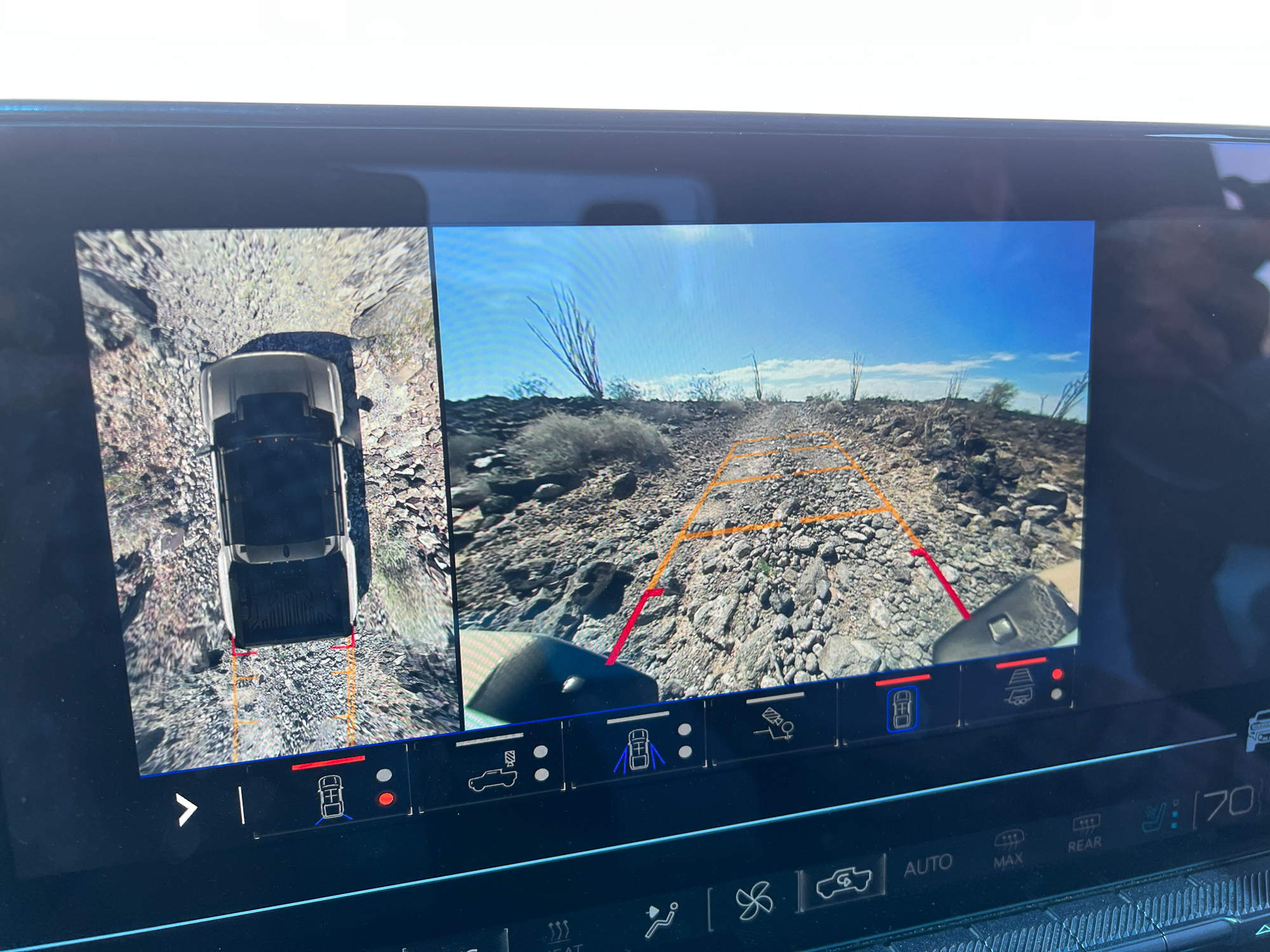
The Hummer comes complete with numerous cameras, including underbody units. This greatly aids the driver given that it is such a wide vehicle.
When considering an EV, a few key factors should be considered. Range is important, but it isn’t everything. In our testing, 300 is the magic number and worked for the most remote point test and the longest overland track test. While you can carry a can of fuel in an ICE vehicle, the EV also has a way to make power that the ICE cannot—regen braking. On a hilly track, EVs make an impressive amount of power, adding to the available range. We also found that tire/wheel diameter is extremely important for rock/ledge performance and flotation. EVs are heavy and need the most flotation possible for sand and snow.
Electric Vehicles: Testing
We tested these three EV trucks over four months, including having the Rivian and Hummer at the same time. Our goal was to live with and learn what it means to daily drive and overland in an EV. We also chose a unique challenge for each of the three vehicles, using the Ford to tow a 7,000-pound trailer nearly 700 miles, the Hummer to cross the longest overland trail in the contiguous 48 states, and the Rivian to access our favorite remote campsite on the Grand Canyon. Each of these scenarios taught us important lessons; in all cases, the EVs exceeded expectations.
Additional testing included ramp travel index, technical trail use, towing, high-speed dirt handling, water crossings, and range validation. We scored each vehicle for its combined objective and subjective outcomes and recorded them in the included chart. While we have tested vehicles as both journalists and OEM validators, EVs are certainly a new skill set. Any errors are noted in the chart.
Ford Lightning XLT Twin Motor, Extended Range
Payload 1,950 | $86,409
This is the electric truck for everyone.

Ford has been a pioneer with their F-150 for decades, taking big risks to push performance and technology with the use of aluminum, a turbocharged V6, and then the groundbreaking Raptor. Their gambles continue with the Lightning EV, which is sold out into the foreseeable future, and on track to sell 150,000 units in model year 2023. Ford built an EV truck that is suitable for many consumers and has a standard bed that will work with a traditional slide-in camper. We know this is only the beginning, and expect Ford to fill out the lineup with off-road variants before long.
The Lightning is so understated (a good thing) that it never stood out during the testing period. It was only a Rivian engineer at a charging station that recognized it and knew how special it was, one of the few test units on the road in the country. Yet the Ford reflected thoughtful engineering and user experience throughout, being as easy and familiar to drive as any half-ton pickup. You only knew it was electric because of the silent operation and blistering acceleration.
On the highway, the Ford was the most composed of the test, benefiting from a wide track, long wheelbase, and lower overall roll center (not to be confused with center of gravity, which we could not test). The Lightning is also the most road-biased of the test, with highway tires and heavy anti-roll bars. It cruised effortlessly down the road with available BlueCruise semi-autonomous driving. The 430 horsepower moves the truck with authority, even when towing. I hooked a 26-foot, 7,000-pound trailer to the Lightning and towed it over 700 miles from Prescott to Los Angeles—and back. The Lightning proved the most suitable towing model in the test (although all are good at towing performance).
For trail use, the Lightning has 8.4 inches of ground clearance and a 24-degree approach angle. The Ford is the least capable of the test, sporting oversized wheels and small tires. It has half the articulation of the Rivian and, as a result, struggled to maintain traction and stability on the trail. The Ford does work in most dirt road conditions and on mild trails with the aid of the rear-locking differential, but it would not be a good choice for technical routes. In overland travel conditions, the F-150 works like most half-ton trucks, with an impressive 10,000-pound max tow package and a 1,950-pound payload (best in test). The bed and frunk are roomy, allowing for expansive gear storage or even the fitment of a camper.
Pros
- Seamless EV experience
- Good towing performance
- Capable of supporting a bed camper
Cons
- Limited suspension articulation
- Limited ground clearance
- Lacks off-road package
Rivian R1T Edition One, Adventure Value Award and Editor’s Choice
Payload 1,600 | $89,500
If Herman Miller built the perfect overland EV…

Rivian is an automotive technology company that began in 2009 with aspirations to build a mid-engine sportscar. Fortunately, they shifted their focus toward trucks and SUVs in 2015, even acquiring a manufacturing plant in Normal, Illinois. By the end of 2021, Rivian had bested the big three by delivering the first electric truck to North American consumers.
Approaching the R1T, it is elegant in its design yet squared off enough to look recognizable as a truck. The approach, breakover, and departure angles are an impressive 35.5/26.4/30, respectively, besting any mid-size pickup overall. The bed is noticeably short at 54 inches, but dropping the tailgate extends it to an impressive 84 inches, long enough for hauling a motorcycle. Driving the Rivian around Prescott, Arizona, resulted in interest or excitement from a melting pot of residents, with the most common question being, “What is the range?”
On the road, the truck is a genuine joy to drive, with the most elegant and minimalist interior of any vehicle I have ever tested. My bias here acknowledges that it won’t be for everyone, but the Forest Edge with open-pore ash wood and olive synthetic leather was distinctly defined. The ride quality is comfortable, reflective of the airbag independent suspension, and steering precision is good, proving to be direct without unnecessary driver fatigue. The 835 horsepower is mind-melting, with 0-60 coming just over three seconds, despite the elevation, and passing is blindingly fast. The only unexpected deficiency was the autonomous driving mode, which lacked precision on all but the straightest highways.
For overland travel, we used the Rivian R1T to travel solo to a remote campsite on the Grand Canyon, requiring 64 miles of dirt travel and nearly 180 miles total between charging. This track included mud, ruts, and loose climbs. The R1T had an easy time with the challenges, but I would like to see a higher wheelspin threshold in mud mode and the highest suspension setting. It had rained overnight, and we needed the clearance due to the depth of the rut, but the mud was thick enough to require high wheelspin to clear the tread. We also tested the R1T on our high-clearance test track (few test vehicles are considered for this trail), and it showcased the 15 inches of ground clearance and performance on rocks and ledges.
Pros
- Nearly ideal confluence of style, capability, comfort, and capacity
- Right-sized for capacity and maneuverability
- Purpose-built for EV overlanding, even with Camp Mode
Cons
- Needs an 18-inch wheel
- Needs CarPlay to support navigation apps
- Complex in ways it doesn’t need to be (charge door and center console latch)
Hummer EV Edition 1
Payload 1,300 | $108,700
GM provides an onslaught of technology and capability in their first EV truck.

GM is on a roll, producing some of the most overland-capable trucks in the industry, like the AEV Bison, the AEV Sierra AT4x, and now the Hummer EV. And these trucks are not just marginally better but a significant step forward in capability. Thankfully, they have also completely avoided the wide-body, go-fast fashion trucks, which are light on payload and even lighter on usability. GM has demonstrated its commitment to the overland traveler, and the new EVs are no exception.
Any review of the Hummer would be incomplete without a rundown of the vehicle’s capabilities. The truck starts off with an astonishing 1,000 horsepower and a 0-60 time of three seconds. It continues with over 350 miles of range and 350 kilowatts of fast charging. On the trail, the GMC has a four-corner long-travel independent airbag suspension, with multiple height settings and even extract mode with a possible 6 inches of lift. There is a rear dual-motor virtual locker and a front driver-actuated mechanical locker. Front and rear steering (with Crab Walk) turns 35-inch Goodyear Wranglers on 18-inch wheels, and the entire undercarriage is a massive and smooth skid plate.
While driving the Hummer on the highway, it emulates a magic carpet ride, with swift acceleration, plush airbag suspension, and a voluminous interior. On most highways, the Hummer drives itself, and will even activate the turn signals and pass slower traffic without any driver intervention. It is far easier to drive than its size would indicate, and all of these features help to reduce driver fatigue on long journeys. The one item that adds to driver fatigue is the clear roof panels, which I would recommend avoiding. Oh, and the review would be remiss without the pubescent glee of WTF mode, which lowers the suspension, and prepares the motors for a three-second 0-60 vaulting that would make a SpaceX engineer squeal.
As an overland vehicle, the Hummer is well-suited. To prove it, we crossed the longest continuous overland trail in the 48 states, traversing over 150 miles of dirt on El Camino Del Diablo (it finished with nearly 80 miles to spare). This trail is truly remote along the border with Mexico and does not have a single provision for charging from Ajo to Yuma, all off-highway. The GMC was nearly flawless, negotiating mud, deep sand, rock, and high-speed gravel sections. The ride quality is the best in the segment, greatly aided by the tall section height tire (which can be aired down more). The Hummer performed the best in the segment on large rocks and ledges, benefiting from taller tires (leverage), lower air pressures (deformation), and the mechanical front locker (no electronic intervention). The only frustration is the odd bed shape and the angled rear cab. It makes fitting a camper nearly impossible and takes away from the premium design with the Avalanche/Ridgeline vestigial.
Pros
- Excellent ride quality on road and off
- Best rock and ledge performance
- Broad spectrum of technology and performance
- 35-inch tires (37s fit) on 18-inch wheels
Cons
- Clear roof panels (replace or tint)
- Needs accessory-on mode to run fridges, etc., in camp
- The angle of the cab/bed interface is not functional
Electric Vehicles: Conclusions
In what seems like an apples-to-apples comparison, we ended up with a granny smith, cherimoya, and mangosteen. For conclusions, it feels best to describe their ideal use case. The Ford is perfect for the daily driver who wants to do all the truck things, including mounting a low-profile camper in the back. It is the lowest cost but also the least capable of the test (by a significant margin). The GMC Hummer is an explosion of personality and technology, and is the largest and most expensive vehicle in the test. The Hummer works the best in mixed terrain, even on most rock and ledge conditions. Its only limitation on the trail is breakover/quarter-panel clearance and overall size. While driving it overland is excellent, the bed configuration and lack of always-on ports make it less flexible. The Rivian is the most balanced of the units, performing well in the majority of scenarios, while simultaneously being attractively designed.
For the Value Award, we are not concerned about the lowest price, although it is a factor. We are looking for the option that achieves the best combination of performance and price. The Lightning and the R1T express these attributes, with the Ford having the best general utility of the test, and the Rivian having the best overall performance. Curiously, the Lightning and Rivian are closer in price than you might expect, the R1T only being three percent more expensive than the XLT. If you need to haul stuff or install a camper, then the Lighting is the best choice. Otherwise, the Rivian is an impressive value (for an EV) and wins our Value Award.
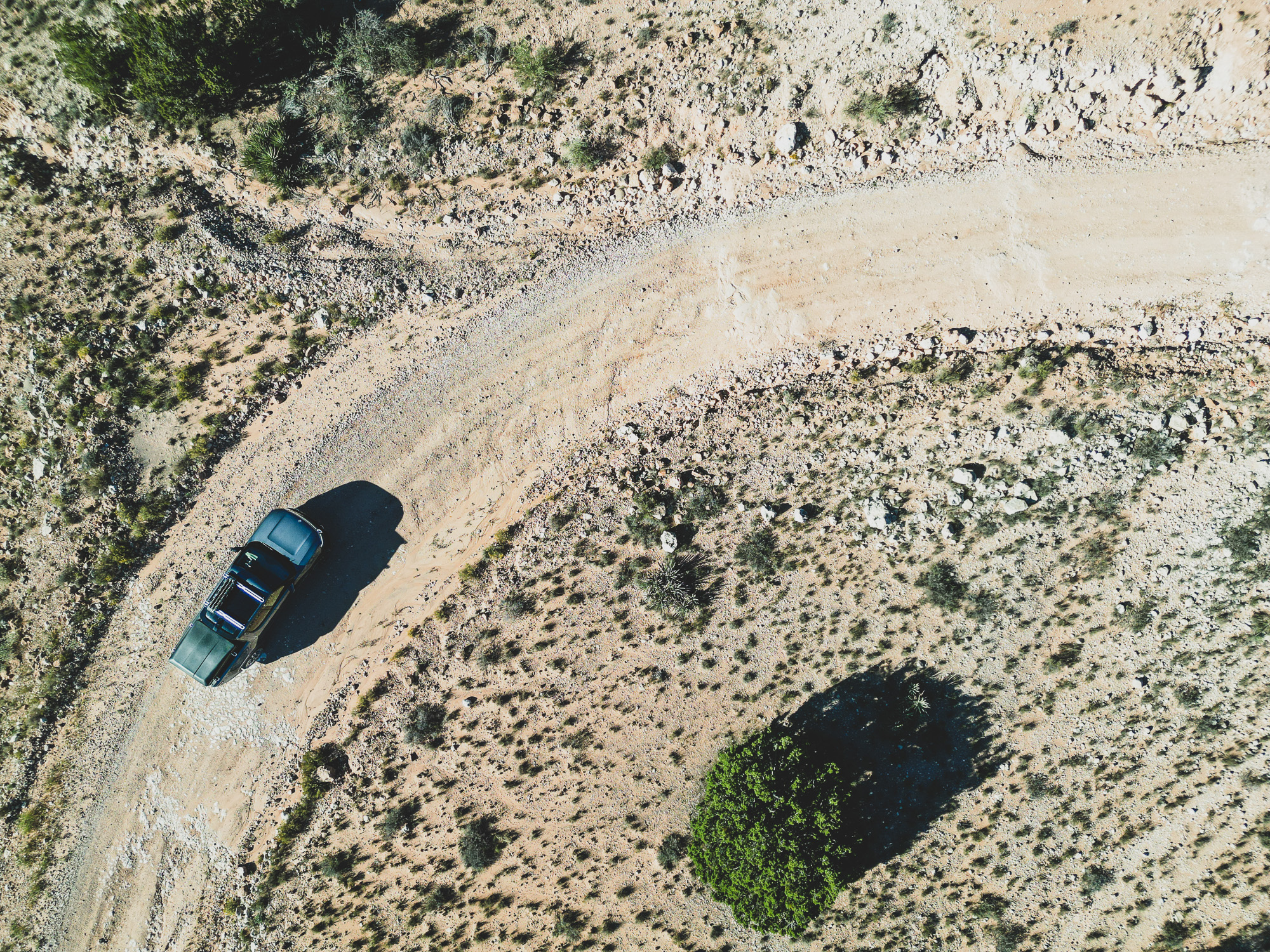
Ultimately, EVs are just another option for the overland buyer. For some travelers, they will be the perfect choice, and for others, the range anxiety or charging infrastructure makes the technology too undeveloped for their needs.
Our most coveted award is the Editor’s Choice, which is the vehicle we would buy, despite the price. It may not be the best choice for every reader, but it is the best choice for us. This came down to the GMC Hummer and Rivian R1T. The Hummer is a technological masterpiece with the best tractive performance in the test. It also has the best ride quality on road and off, with a stately manner. Even though it is massive, it is surprisingly maneuverable in most conditions (thanks to four-wheel steering), but it will be a challenge to fit down many trails, and the low-hanging quarter panels are prone to impact. I also struggled with its functionality as a truck, and I suspect I would prefer the SUV variant for most scenarios. The Hummer is impressive, but not necessarily in the ways I need it to be. That leads me to the Rivian, which did everything I asked of it, and ultimately charmed me beyond expectation. It is just the right size and was able to negotiate all of my milestone trails, including the technical test track we reserve for only the most capable stock 4WDs. My one notable complaint is that the 20-inch wheels are fundamentally mismatched to such a capable and heavy vehicle (18s can be done, and the heavier GMC Hummer proves that). If there is an EV made for me, it would be the R1T. I did everything possible to not send the Rivian back, including trying to buy it personally.
It is exciting to see EV technology evolve and begin meeting the needs of overlanders. The category will continue to advance at a rapid rate and hopefully be supported by a robust charging infrastructure. They do not need to replace ICE vehicles, but they do complement the broader transportation market. If you are feeling suspicious about EVs, I would suggest going on a test drive—there is nothing like a 4WD on 35s going 0-60 in 3 seconds and then raising the suspension to drive to the most remote point in the 48 states—it might make you a believer.
Read More:
North American Electric Vehicles Launches Executive Edition Cyber-Hummer EV
Our No Compromise Clause: We carefully screen all contributors to ensure they are independent and impartial. We never have and never will accept advertorial, and we do not allow advertising to influence our product or destination reviews.


